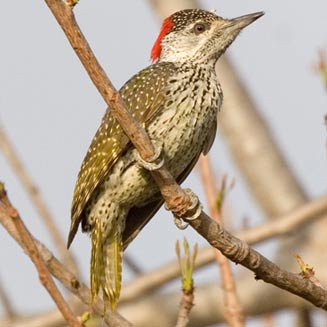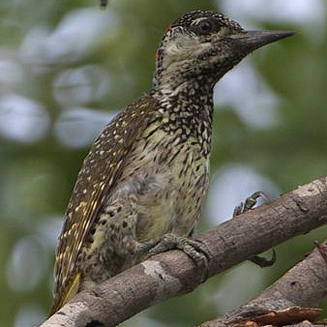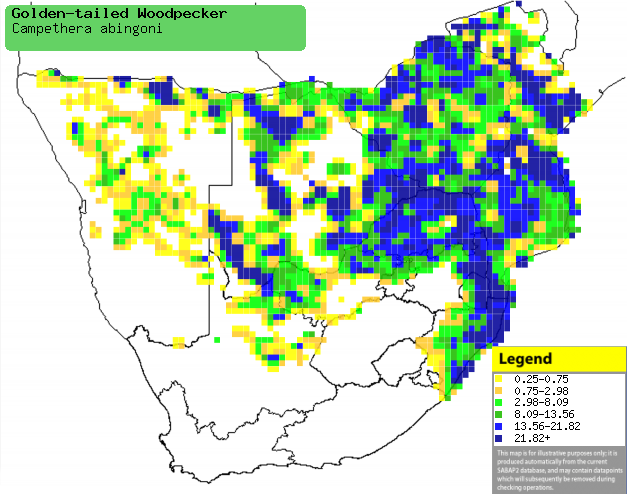|
Campethera abingoni
(Golden-tailed woodpecker)
Goudstertspeg [Afrikaans]; iSibagwebe, isiQophamuthi,
uSibagwebe [Zulu]; Mbangura (generic term for woodpecker and also applied to
Crested barbet) [Kwangali]; Hohodza (generic name for woodpecker) [Shona];
Ghongoswana (generic term for woodpecker) [Tsonga]; Kôkômere, Phaphadikôta
[Tswana]; Goudstaartspecht [Dutch]; Pic à queue dorée [French];
Goldschwanzspecht [German]; Pica-pau-de-rabo-dourado [Portuguese]
Life
> Eukaryotes >
Opisthokonta
> Metazoa (animals) >
Bilateria >
Deuterostomia > Chordata >
Craniata > Vertebrata (vertebrates) > Gnathostomata (jawed
vertebrates) > Teleostomi (teleost fish) > Osteichthyes (bony fish) > Class:
Sarcopterygii (lobe-finned
fish) > Stegocephalia (terrestrial
vertebrates) > Tetrapoda
(four-legged vertebrates) > Reptiliomorpha > Amniota >
Reptilia (reptiles) >
Romeriida > Diapsida > Archosauromorpha > Archosauria >
Dinosauria
(dinosaurs) > Saurischia > Theropoda (bipedal predatory dinosaurs) >
Coelurosauria > Maniraptora > Aves
(birds) >
Order: Piciformes
> Family: Picidae
 |
 |
|
Female Golden-tailed woodpecker. [photo
Neil Gray
©] |
Female golden-tailed woodpecker, Shamvura, Namibia. [photo Trevor Hardaker ©] |
The Golden-tailed woodpecker is fairly common in sub-saharan
Africa, preferring riparian, Miombo and Mopane woodland. It mainly forages in
trees, tapping and probing branches, looking for insects and licking them up with
its barbed tongue. Both sexes excavate the nest, which is usually a hole in the underside of
a tree branch. Here it lays 2-3 eggs, which are incubated by both sexes for about 13
days. The chicks are cared for by both parents, eventually leaving the nest
after about 22-25 days. They become fully independent a few weeks after
fledging.
Distribution and habitat
Mainly occurs from Angola and Tanzania to South Africa,
with isolated populations in East Africa. In southern Africa, it is fairly
common in Zimbabwe, Mozambique, Botswana, parts of Namibia and north-eastern
South Africa. It generally
prefers
riparian woodland, thickets, Miombo (Brachystegia), Mopane (Colosphermum
mopane) and Burkea (Burkea africana) woodland.
|
 |
|
Distribution of Golden-tailed woodpecker in southern Africa,
based on statistical smoothing of the records from first SA Bird Atlas
Project (©
Animal Demography unit, University of
Cape Town; smoothing by Birgit Erni and Francesca Little). Colours range
from dark blue (most common) through to yellow (least common).
See here for the latest distribution
from the SABAP2. |
Brood parasites
It has been recorded as host of the
following birds:
Food
Mainly forages in trees,
tapping and probing branches in search of insects, then licking them up with its
barbed tongue. It may also excavate insect nests and glean ants from branches.
The following food items have been recorded in its diet:
Breeding
- Both sexes excavate the nest, which is usually a hole in the underside of
a tree branch, occasionally used over multiple seasons.
- Egg-laying season is from August-December, peaking from
September-November.
- It lays 2-3 eggs, which are incubated by both sexes for about 13
days.
- The chicks are cared for by both parents, eventually leaving the nest
after about 22-25 days. They become fully independent a few weeks after
fledging.
Threats
Not threatened.
References
-
Hockey PAR, Dean WRJ and Ryan PG (eds) 2005. Roberts -
Birds of southern Africa, VIIth ed. The Trustees of the John Voelcker
Bird Book Fund, Cape Town.
|
